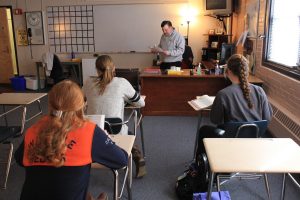
Imagine that your doctor just told you that you have a concussion. It’s a Thursday night, and you have a full day of classes tomorrow — classes with tests to study for and homework that you need to complete. Suddenly, your doctor tells you that you cannot do any work, and you need to miss a portion of school in order for your brain to heal. Once your concussion is healed, you arrive back at school, and a pit of worry grows in your stomach, as you stress over the herculean workload that you have to make up in all of your classes. Imagine your classmates study for a Vocabulary Section 8 exam, while you have not yet taken the quizzes for Vocabulary sections 5-7. Now — imagine that amount of work but for every class. Imagine the scope of work to be done. Imagine the overwhelming, paralytic stress.
At Walpole High School, there is now an answer for those worried students who have been absent from school for a long time: the Transition Program.
The Transition Program’s main goal is to help students who have been absent from school for a significant period of time transition easily back into the school schedule with less pressure to make up his or her work all at once. The usual process of the Transition Program starts with the student meeting with the parents, the assistant principals, the school nurse, the guidance counselor, and Transition Program Coordinator Ronald Dowd to discuss how the institution will help the student assimilate back into the school society.
As the student progressively comes back to school, Mr. Dowd collects the student’s work and communicates with all the student’s teachers throughout the student’s stay in the Transition Program. Over time, the student gradually makes up all of his or her missed work, including tests and quizzes. The average length of time a student continues in the program is 19 school days.
Sophomore Julia Savastano participated in the Transition Program in October 2013 for two months as a result of a concussion. She said, “The program helped ease a lot of my stress going back with all the makeup work I was given after being out for over a week and only going to school half days for a while. Obviously, being out that long, I had a lot of makeup work, and with the program, I was able to take my time making everything up.”
Since the beginning of the year, the project has helped 44 students by slowly assimilating them back into school. Many of the participants generally suffer from concussions, operations, and long-term illnesses (like mono) that cause them to miss a large portion of school time.
“The biggest challenge for the students is organizing the time and realizing that not everything has to be done today,” said Mr. Dowd.
To alleviate that stress for students in the program, Mr. Dowd organizes the students’ homework and classwork that they missed during their absences. The students then stay in the Transition room for a portion of the day — sometimes just a period or two — with Mr. Dowd where the student makes up the work in the most expeditious way possible.
In the last couple of years, Walpole is one of many schools, including Wayland High School and Weston High School, trying out a Transition Program to observe how it helps its students.
Looking to the future with the Transition Program, Savastano said, “I think that the Transition Program is a great addition to Walpole High School and will help a lot of students who will need it for various reasons.”
With society’s growing concern over the impacts of concussions on the adolescent brain, this program will continue to be a valuable resource not only to affected students in Walpole High School, but also to other school administrators looking to adopt a similar program.








